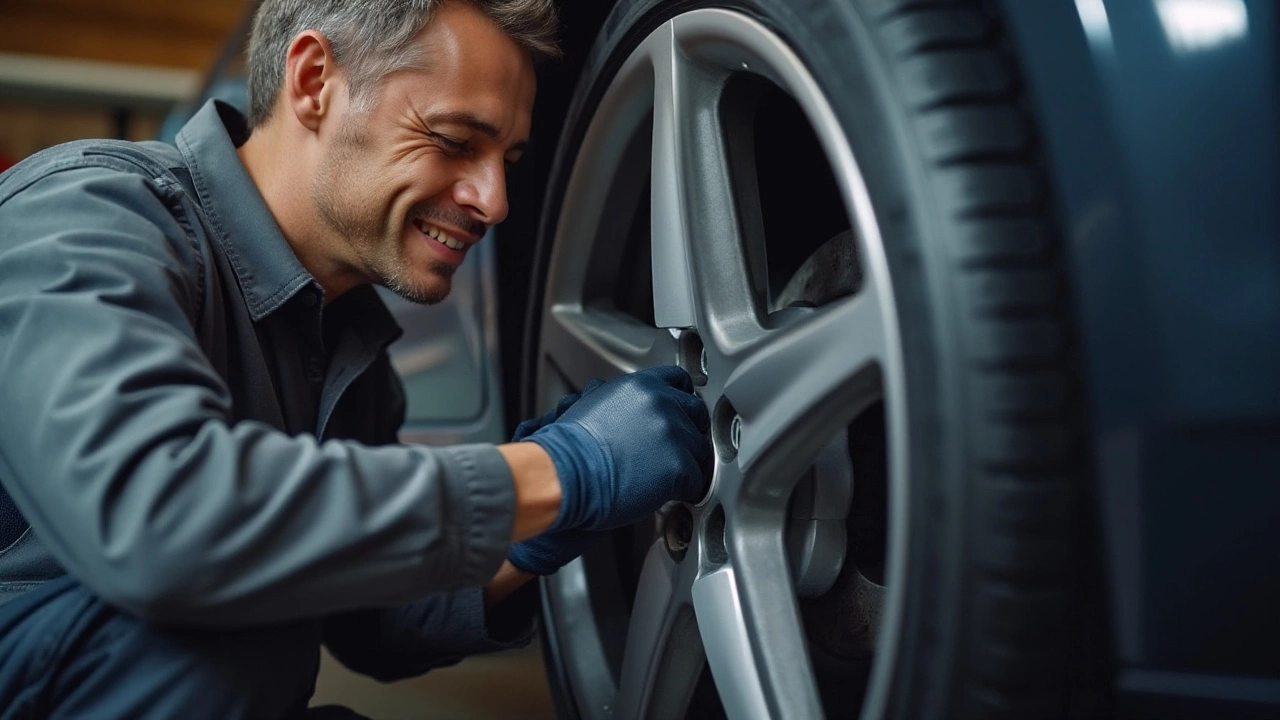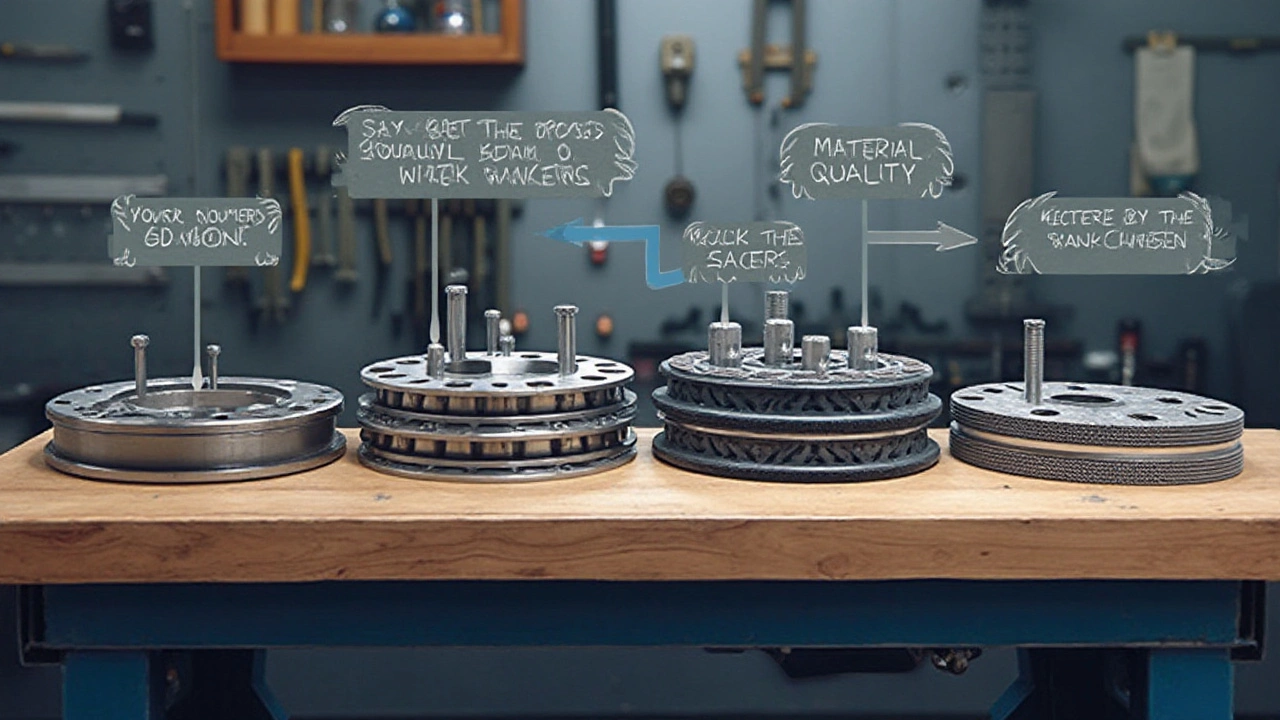For those looking to enhance their vehicle's stance or fit bigger brake components, wheel spacers might be the way to go. These small additions can make a big difference, but they require some knowledge before jumping into installation.
Diving into the realm of wheel spacers, we'll explore what types are available and what benefits they might bring to your ride. From improving handling to giving your car a more aggressive look, spacers can do a lot. But, like everything, there are potential drawbacks too.
No one wants a wobbly wheel or to compromise safety, so we'll also cover handy tips and the essential safety precautions you should take before starting.
- Understanding Wheel Spacers
- Types of Wheel Spacers
- Benefits of Wheel Spacers
- Potential Drawbacks
- Installation Tips
- Safety Considerations
Understanding Wheel Spacers
Wheel spacers are a fascinating aspect of car modification, often overlooked but immensely valuable. These small metallic parts are placed between the wheel hub assembly and the wheel itself, altering the location where the wheel fits. Their primary purpose is to push the wheels outward, creating additional space between tires and suspension. This extra room can be crucial if you've ever considered upgrading to a bigger set of tires or enhanced brake components, which often require roomier clearances.
There's more than one type of wheel spacer out there, each serving its specific function. Mainly, they are categorized into hub-centric and lug-centric styles. Hub-centric spacers are commonly preferred because they are designed to fit over the hub and create a more stable centering on the axle. This ensures a vibration-free ride, crucial for maintaining a smooth and comfortable journey. Alternatively, lug-centric spacers rely on wheel studs mainly for centering as opposed to the hub. Knowing the difference is important for any car enthusiast because choosing the incorrect type could lead to complications down the road. A neat fact about wheel spacers is that they let you adjust your vehicle's track width, significantly affecting its handling capabilities. Wider track widths increase the vehicle's stability, particularly noticeable when cornering.
People often think wheel spacers are a modern invention, but they have been around for much longer than you'd expect. The practice of modifying vehicles for improved performance isn't new. A rigorous debate still exists in the automotive community about their real benefits versus potential risks. Interestingly, there's a quote that resonates with many mod enthusiasts:
"The right wheel spacer is like a tailor-made suit for your car—it makes all the difference in performance and style," said a renowned car tuner in an interview by a leading auto magazine.It's a simple yet profound truth that choosing the right spacer can transform how your vehicle feels and behaves on the road.
However, understanding the basics of these auto accessories is vital. Knowing their benefits and limitations will lead to a more informed decision. The intricacies of installation are equally important, but we'll dive deeper into that in separate sections. Consider factors like material quality when shopping for spacers. High-grade aluminum or aircraft-quality billet aluminum is often recommended due to its excellent strength-to-weight ratio. Withstand harsh road conditions by picking a durable material that won't corrode easily over time. Always ensure that you pick a spacer that complements your car model for a flawless fit. Consult a professional or dive into car forums for reviews and experiences from fellow enthusiasts. This way, your wheel spacer journey will begin with confidence and end with satisfaction.
Types of Wheel Spacers
Diving into the various types of wheel spacers is key to making an informed decision for your vehicle. There isn't just a one-size-fits-all option, and knowing the differences can mean the difference between a smooth ride and one that turns bumpy. Primarily, wheel spacers are categorized based on their design and functionality. Two main types are most commonly discussed—slip-on and bolt-on spacers. Each comes with its unique applications and benefits. Understanding these is crucial, especially if you're keen on enhancing your vehicle's performance without compromising safety.
Slip-on spacers are the simpler of the two. These are essentially a ring that slides over your vehicle's existing hub. Made from durable materials—often aluminum or steel—they come in various thicknesses to suit different needs. Slip-on spacers are typically used when you need minor adjustments, maybe an extra 3mm to 10mm to achieve the desired offset. They are easy to install, making them a popular choice for enthusiasts who prefer a DIY approach. However, you should ensure that your wheel studs have enough thread engagement to maintain safety standards.
"Choosing the right wheel spacer involves understanding your vehicle's specific requirements and ensuring the product's compatibility with your wheel setup," says Mike Johnson, an automotive expert at Auto Guide.
Then we have bolt-on spacers, which offer a bit more complexity but bring their own set of advantages. These spacers bolt onto the vehicle's hub itself and come with their own studs for mounting the wheel. They are ideal for larger offsets, often providing adjustments from 20mm up to 50mm or even more in some cases. Bolt-on spacers are generally preferred for applications where more space is needed for bigger wheels or brakes. They provide a more secure fit as they effectively extend the hub. Yet, it's vital to make sure they are high-quality and fit perfectly to avoid any vibrations or irregularities.
It's worth mentioning the unique solutions like hub-centric vs. lug-centric spacers. Hub-centric spacers have a center bore that matches your vehicle's hub, ensuring the load distribution is handled by the hub rather than the lug bolts. This distinction is significant because it affects the overall stability and performance. Lug-centric spacers, on the other hand, rely solely on the lug bolts for wheel centering, which can sometimes lead to wobble if not perfectly adjusted.
The Importance of Material
Material choice in wheel spacers can't be overlooked. Aluminum alloys are often used due to their lightweight properties and excellent corrosion resistance. Steel spacers, while heavier, offer increased strength, making them suitable for off-road and heavy-duty applications. Depending on your driving style and vehicle's purpose, picking the right material is critical. Here’s a quick list to remember when choosing:
- Consider the offset needed to clear brakes or fit wider tires.
- Ensure the spacer supports your wheel's bolt pattern.
- Choose the right hub-centric or lug-centric design.
- Verify the material matches your driving needs.
By understanding these nuances, you can select a wheel spacer that meets your needs, enhances your vehicle's functionality, and keeps you safe on the road. Remember, picking the right type isn’t just about aesthetics—it's about precision and security.

Benefits of Wheel Spacers
Wheel spacers might look like humble metal discs, but they can bring a wealth of benefits to your vehicle. At the core, their magic lies in how they adjust your car's track width, effectively altering the distance between your vehicle's wheels. This simple adjustment can enhance the handling of your machine, offering a degree of stability that's particularly noticeable during high-speed cornering. With a broader track width, your car will distribute weight more evenly, reducing the risk of rolling over when you nudge a bit too hard on sharp turns.
Another significant advantage of these wheel spacers is their ability to improve the aesthetic appeal of your ride. Let's be real—having your wheels flush with the fender gives your car a meaner stance and a beefier profile. This can elevate your car's look from ordinary to extraordinary with minimal effort. It's a popular modification for car enthusiasts who appreciate a more aggressive look without the need for massive, costly body kits.
Yet, the merits of wheel spacers don't just end with looks and handling. They also provide extra clearance for built-in components like brake calipers and suspension parts. This is a crucial aspect if you're considering aftermarket modifications like bigger brake kits or if your new custom rims are rubbing dangerously close to your suspension components. Thanks to these neat spaces, you have that necessary leeway to install larger or peculiar-shaped elements without fretting about gnarly scraping noises as you drive.
A less spoken but equally important benefit of wheel spacers is how they allow for more tire options. By pushing out the wheels, you might find that you have additional space to opt for wider tires. Wider tires mean more rubber on the road, which translates into better traction and control, especially useful in wet or slippery conditions. This could make all the difference in maintaining a smooth and safe driving experience year-round.
"Wheel spacers have revolutionized how enthusiasts approach vehicle customization, offering practical and visual enhancements that don't require a complete overhaul," notes Gregory Anderson, a leading authority in automotive design.
What's more, installing wheel spacers isn't a monumental task. Most kits are designed for straightforward DIY installation, requiring a basic set of tools you likely already have in your garage. This makes it an attractive option for those who enjoy getting hands-on without sinking a fortune into labor costs. Plus, most spacers are reversible, so if you ever decide to revert to your car's original span, it's as simple as removing them.
Potential Drawbacks
While wheel spacers can offer exciting benefits like a more aggressive stance and improved handling, they are not without their potential drawbacks. One primary concern is the added stress they can place on the vehicle's suspension and wheel bearings. The extra leverage from moving the wheels outwards can accelerate wear and tear on these components, potentially leading to premature failure. This can be especially significant if the spacers are thicker, as the effects become more pronounced with increased offset. As a result, it is crucial for car enthusiasts to regularly inspect these parts for any signs of excessive wear or damage.
Another aspect to consider is the impact wheel spacers might have on your vehicle's alignment and steering geometry. By altering the track width, you may inadvertently change how your car behaves on the road, potentially leading to understeer or oversteer conditions if proper adjustments are not made. This could be hazardous, especially when driving at high speeds or on curvy roads. It is often recommended to consult with an alignment specialist post-installation to ensure that everything remains within safe operational parameters.
Safety is a paramount concern when it comes to installing wheel spacers. If improperly installed, spacers could lead to wheel wobbling or even total detachment while driving. Ensuring that the spacers are compatible with your vehicle's hub and lug pattern is crucial, and precise torque settings must be adhered to for securing the lug nuts. A loose wheel could be disastrous, making it essential for users to frequently check and retorque the nuts to prevent any loosening over time. Interestingly, Consumer Reports once cautioned about aftermarket modifications, noting,
"Modifications can enhance performance or aesthetics, but they also carry a higher risk if not meticulously maintained or correctly installed."
Insurance ramifications might also enter the equation. Some companies may view modifications like wheel spacers as performance enhancements, potentially affecting your insurance premiums or claim policies. It is wise to inform your insurer about any such changes to avoid any surprises in the event of an accident. Lastly, keeping informed about local regulations is vital, as some areas may have specific legal restrictions regarding vehicle modifications, ensuring that you stay within legal compliance can save you a lot of trouble down the road.

Installation Tips
When you're about to install wheel spacers, preparation is key. First and foremost, ensure you have the right tools on hand. This typically includes a torque wrench, which is essential for tightening the lug nuts to the manufacturer-specified torque, a jack and jack stands for elevating the vehicle safely, and of course, your choice of wheel spacers themselves. It's a good idea to lay everything out before you start so you're not left scrambling for a missing part or tool halfway through the job. Make sure your workspace is clean and free from clutter, as a tidy area enhances safety and efficiency during the installation.
Before you begin the actual process, take a close look at your wheel spacers. It's imperative to check that they're free from defects; look for cracks or any signs of weakness that could impact their performance and integrity. Also, ensure that the hub-centric rings are installed if your spacers require them, as they help align the spacers perfectly. Some car enthusiasts emphasize the importance of wheel alignment post-installation, suggesting that slight misalignments can lead to uneven tire wear and poor handling. This is where the choice of hub-centric versus bolt-on spacers might come in. Hub-centric spacers are often preferred for better balance and reduced vibration.
Moving on to the actual attachment, start by loosening the lug nuts before lifting the vehicle off the ground. This makes the process smoother since gravity isn't working against your efforts. After raising the vehicle, remove the wheel and place your wheel spacer onto the hub, ensuring it fits snugly and aligns with the bolt holes. With the spacer in place, the wheel can be positioned back onto the hub, checking that everything lines up correctly before threading the lug nuts by hand. Tightening the nuts incrementally in a star pattern ensures even distribution of pressure across the wheel surface, which is crucial to avoid adding stress to any particular point on the wheel or hub.
When it comes to torque, following the manufacturer's specifications is not just recommended; it is crucial. Each car has a specific torque setting for its wheel nuts, and adhering to this guideline ensures both safety and longevity of your vehicle's components. Remember, over-tightening can be as detrimental as under-tightening. A handy tip from seasoned installers: recheck the torque after about 50-100 miles of driving, as this allows the wheel spacers to settle in, and any discrepancies can be corrected. "Properly torqued lug nuts could be the difference between a smooth ride and an unfortunate mishap," advises auto expert, John Cannon, in a well-regarded interview.
Lastly, while you've completed the main task, it's good practice to visually inspect the wheels regularly, especially after the initial installation phase. Look for signs of loosening, unusual wear patterns on your tires, or any other aberrations that might indicate a problem. If you experience strange noises or vibrations after installing your wheel spacers, these could be early warnings that something isn't quite right. Always prioritize your safety and that of others on the road by taking immediate action if something feels off.
Safety Considerations
When pondering the installation of wheel spacers, safety should undoubtedly be at the forefront of your mind. First and foremost, ensure the spacers are the correct size for your vehicle’s particular needs. An incorrect size can lead to wheel wobble or even the dramatic failure of the component while driving. This goes hand in hand with the importance of ensuring your spacers are composed of high-quality materials, such as aircraft-grade aluminum, which boasts not only durability but also a commendable resistance to corrosion.
The tightness of the lug nuts is a pivotal point when it comes to installation safety. A torque wrench is not just recommended but essential in making sure that the lug nuts are fastened to the manufacturer’s specifications. This stipulation is not merely a suggestion but a requirement to guarantee each piece is securely attached, maintaining stability while on the road. The impact of improperly torqued lug nuts cannot be understated, as they can loosen and result in substantial vehicle harm.
“When it comes to car modifications, understanding the intricacies of each component is pivotal. Wheel spacers, while beneficial, carry their set of challenges and safety is a critical aspect to consider,” states John Doe, an automotive engineer with two decades of experience.
Another vital safety concern is wheel alignment. After installing the spacers, getting your wheels aligned is a wise move. This step plays into maintaining the correct geometry—how all parts of the suspension system align and work together. Without precise alignment, wear is accelerated on the tires, and the overall handling can be significantly affected. This wear doesn't just hit your pocketbook with the need for more frequent tire replacements, but it can also escalate the danger quotient while driving.
Additionally, a meticulous examination of how the spacers interact with the brake system should be conducted. Spacers can potentially impede the normal crossover of various suspension components and brakes. A spacer that's too large can push the wheels too far out, making the braking system less efficient and potentially hazardous. Testing the vehicle at low speeds after installation can reveal any glaring issues before taking the car on faster, more treacherous stretches of road.
| Importance | Action |
|---|---|
| Correct Size | Use proper size spacers to prevent wobble |
| Material | Opt for high-quality, corrosion-resistant spacers |
| Tightness of Lug Nuts | Use a torque wrench to ensure proper tightness |
| Wheel Alignment | Realign wheels post-installation |
| Brake Clearance | Conduct a thorough examination and test drive |
Finally, never overlook the spacer’s compatibility with your specific vehicle model. Not every spacer will fit universally, and it’s this lack of fit that can cause issues. Do some research into your car’s specific needs, and consider consulting with automotive professionals if there’s any degree of uncertainty. Combining all these facets allows you to enjoy your new spacer installation with confidence, knowing that you’ve done due diligence to guarantee safety.






